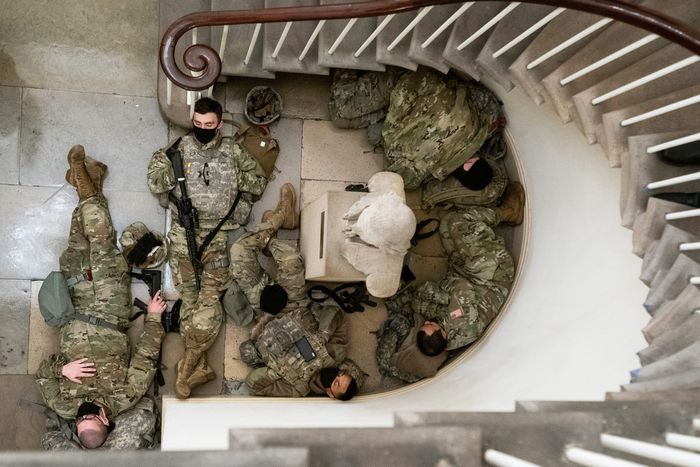
A week after the storming of the Capitol — and less than a week before the inauguration of President-elect Joe Biden — the photos emerging from inside the citadel of democracy were of a military encampment on its marble floors. National Guard units, deployed to keep the peace in this unstable democracy, were bedding down on what had so recently been a battlefield. And even as the House was meeting to beat back sedition with speeches and votes, their workplace had become a different kind of citadel: ringed by metal detectors, steel walls, gates, and troops. The shocking images of January 6 showed us a place of dignity desecrated by dangerous clowns; now, we see a public building locked down as tight as a nuclear installation. That’s a tragic necessity right now, but it suggests a question for these insurrectionist times: Can a fortress still be the people’s house?
One of the ironies in the final spasms of the Trumpian nightmare is that an insurgency nurtured in cyberspace needed to conquer physical space, an actual stone structure, to validate its claims. The president’s inflamed minions believed in election results altered by manipulated code, information beams shot from satellites, and conspiracy theories hatched in chat rooms and distributed by social media. Yet when they showed up in Washington, they trained their eyes on the dome on the Hill and declared it the perfect target. In fact, it seems likely that scouts had scoped it out well before. Representative Mikie Sherrill reported that fellow members had been giving “reconnaissance tours.” Ayanna Pressley’s chief of staff found that all the panic buttons in the office had been removed. Other House Democrats suspected that invaders had gotten inside information on where to go and what to look for. Whether those accusations prove true or not, it’s clear that insurgents traveled across the country, rented hotel rooms, and equipped themselves for battle so that they could attack a work of architecture that they knew from images on TV shows, news footage, and coffee mugs — and, for some, perhaps, from high-school field trips or family visits to Washington. “This is our house,” they screamed, before sacking it.
The action was wrong, but the claim was accurate. Having broken in, all those self-appointed patriots dressed like Visigoths went milling around the halls of power looking variously sheepish, awed, goofy, and murderous. Filing obediently between velvet ropes, they explored the Rotunda and Statuary Hall, places where, at another time and in another way, they would have had every right to be. The Capitol’s architecture is meant to proclaim, among other ideals, that the workings of democracy are transparent and public, and that the halls of government are not remote palaces, but workplaces that are also monuments and museums. Maybe that’s why, when the insurrectionists broke in, many behaved like teenagers in disbelief at their own transgressions but also not quite sure whether they were transgressing at all.
When members of Congress fled the House and Senate chambers, some were led to the underground visitor center, which was designed after two Capitol Police officers were killed in 1998, then redesigned after 9/11, and finally opened in 2008. That $700 million basement, built as an armored buffer between the outside world and inner sanctum, was never supposed to be a fully real place. The Washington Post critic Philip Kennicott, in a scathing review of the addition, wrote that it dulled the experience of visiting the building and offered a digitally vivid pseudo-experience in its place. “We now have a Capitol, and a HyperCapitol, where everything is better presented, cleaner, more dramatically framed. Like the world seen on television, things that were once far away — the dome, the statue on top of the dome — have been brought up close, through models, or interactive screens.” The insurrectionists of January 6 bypassed that air lock and headed straight for the closed doors. Instead of welcoming — or stopping unwelcome — visitors, it became a retreat for members of Congress, then a dormitory for National Guard troops who slumbered there, watched over by a plaster copy of the Statue of Freedom atop the Capitol’s cupola.
It’s hard to keep all the allegories and ironies straight. A rotunda, a dome, marble halls, colonnades, and ceremonial stairs — the architecture that the flag-bearing mob attacked is precisely the kind that Trump, in an executive order making neoclassicism the preferred style for federal buildings, held up as the archetype of all-American beauty. And yet all that perfectly proportioned grace, crammed with references to the Athenian source of our democratic aspirations, was executed by slave labor and streaked with unsavory history. “In the Capitol building, idealized narratives of liberty and democracy rest on brute force,” wrote Los Angeles Times columnist Carolina Miranda. And so now that violence has come full circle, real troops must defend a real building from real attacks by mobs propelled by inchoate fantasies and gossamer promises. Among the many kinds of damage that will require repair in the near future is the Capitol’s ability to remain at once effective, noble, open, and secure.






